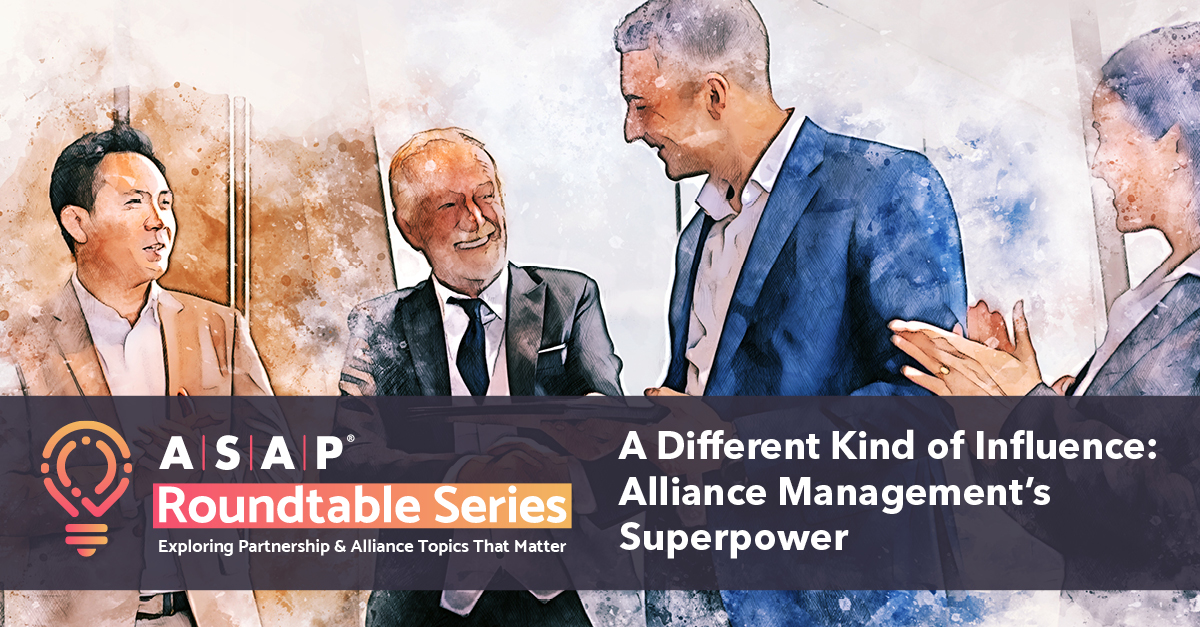A Different Kind of Influence: Alliance Management's Superpower
Influencing without authority. It’s one of the most foundational parts of being an alliance manager.
“This is the most important part of an alliance manager’s job. It’s the hardest and adds the most value,” said Jan Twombly, CSAP, president of The Rhythm of Business. “It’s your superpower.”
And it’s a somewhat unique skill as compared to other jobs and departments within an organization.
“Our role tends to span across several stakeholders,” said Amy Hansen, global alliance manager for data protection at Nutanix.
Hansen and Twombly offered these thoughts in the introductory remarks of the latest ASAP roundtable, “Exercising Influence: The Ingredient Holding Successful Alliances Together.” Along with Kristin Rosner, GBD global alliance management lead at Takeda, and Dionis Taveras, global partner manager at Dell EMC, Hansen and Twombly were part of a foursome that led separate breakout room discussions to trade ideas on the best ways to influence stakeholders in a variety of settings.
Senior Backing Propels the Rest of the Organization Forward
Predictably, roundtable participants across all of the breakout groups identified senior leadership backing as an important source of tailwinds for gaining support from the rest of the organization. One contributor to Taveras’s group spoke of a past work experience where the CEO clearly communicated to the whole company that the organization was shifting its emphasis from direct to indirect sales, and that he expected all divisions to do what was necessary to support this change in strategy.
“Now you start putting substance behind [the change in course],” she said.
“A lot of this is about the C-suite. You need them on board,” agreed another participant.
Taveras noted that he was fortunate to work at Dell EMC, a company that has “great leaders who actually lead. They support me when I need support and provide resources,” in his experience. “If you don’t have senior backing on the back end, it’s hard to do your job.”
Private Line: Smaller Orgs Aren’t Burdened by Long-Distance Connections
Most of the groups discussed the differences between the inner workings of smaller and larger organizations. A person who jumped from a household Big Pharma name to run a smaller biotech’s alliance practice recounted her frustration with having to relay important partnership matters up a chain of two or three levels of executives, only to see her message get garbled in a game of telephone. Now, her CEO is in calls with her and she has no problem getting one-on-one access with him.
“I can have more direct influence because I have the chance to find out what’s concerning them,” she noted.
Without access to the leadership team in large companies, one person in Rosner’s breakout room recommended asking, “Where is the roadblock?” and then “working downward” within teams and functions from there. Another added that it is important to figure out how many levels a key stakeholder is away from the governance structure and then influence the appropriate chain of decision makers accordingly. Rosner herself said that she usually has to relay her messages to Takeda’s C-suite through a JSC member.
A Little Understanding and Some Unique Knowledge Go a Long Way
Selling alliance initiatives comes down to making a good business case, in many instances.
“[Alliances] are usually precipitated by some kind of gap,” one contributor noted. If you do the due diligence and provide a concise summary of why alliance activities are in both the stakeholder’s and the company’s best interests, “the education will sell itself,” said another person in the discussion.
It’s also important to understand fears as much as desires.
Someone in Taveras’s breakout room noted that if the answer to the question, “Is this issue keeping you awake at night?” is yes, then it will be far less challenging to sell an alliance that solves that problem. Rosner told a story of one executive holding up a milestone decision for “fear of being wrong.” After a couple of months of stalling, Rosner enlisted a trusted confidant of that executive to reach out and prod for an answer.
The notion that alliance managers could enhance their reputations in the organization by understanding each department’s objectives was a common theme in Hansen’s group. Alliance managers also have unique knowledge—of subject matter and of people—that can help goad others into action. Properly vet a partner and you can “look like a hero” to your senior leaders, which will extend your influence in the organization, said one person.
“The secret sauce is your breadth of knowledge across the organization,” said another contributor. Bring something useful or helpful to a stakeholder or make a useful introduction, and alliance managers are once again adding value.
Influence is also a hot topic in the Q4 2022 edition of Strategic Alliance Quarterly. Check out Twombly’s contributed article, “Positive Influence: The Alliance Professional’s Superpower,” available in the ASAP Content Hub.

